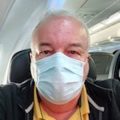
COLIN SIMPSON
Passengers in Hazmat Suits, Empty Airports
and Planes… and Even Duty Free was Closed
WE ALL know air travel has been devastated by the coronavirus, but it’s still a shock when you’re flying during Covid and see the impact with your own eyes.
Before the pandemic, Hong Kong International Airport was one of the world’s busiest. In September last year, 4,857,000 international passengers passed through, according to official figures. And that was a time when tourist numbers had fallen because of violent clashes between anti-government protesters and the police. In September 2020, just 100,000 travellers used the airport – a 97.9 percent drop compared with the same month a year earlier.
So the scenes that greeted my wife Sue and I when we flew out of Hong Kong this month should hardly have been a surprise. But the wide, empty walkways and spaces, designed to move huge numbers of people swiftly and send them on their way, were still a shocking sight. Our passports and boarding cards were checked at the entrance to the terminal – a measure introduced last year to keep protesters out of the building. Our temperature was then measured before we were allowed in.
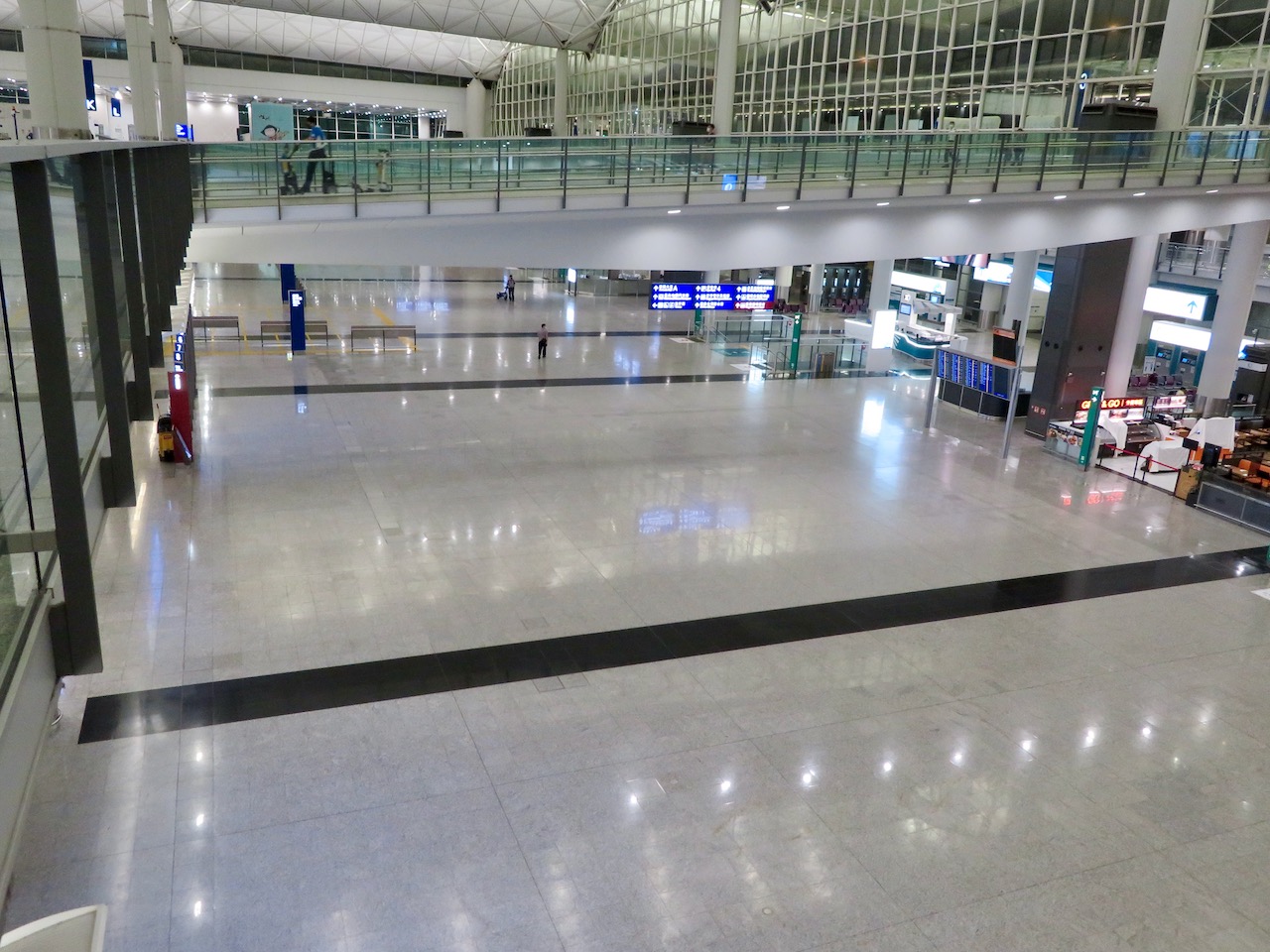

It was then that we first saw those vast deserted spaces. We had always associated HKG with crowds, the buzz and excitement of air travel, and that special pre-holiday sense of anticipation. Now it had become a ghost airport.
Many of the check-in areas were closed, and there were dramatically fewer flights than normal. Before Covid, the airport handled 68 flights per hour at peak times. When we arrived at Terminal 1 – one of the largest in the world – the departures board listed only 27 flights over the following 12 hours – and five of them had been cancelled. There seemed to be more staff than passengers. Some employees pushed lines of trolleys from one end of the empty departure hall to the other. I wouldn’t have been surprised if, when they reached the far end, they turned around and pushed them back. Though obviously I knew the reason for all this, I couldn’t stop myself instinctively wondering where everyone had gone.
Everything Looked Rather Shabby
The baggage drop and security checks were unchanged, though the process was much quicker because of the low number of passengers. When we reached the departure area we found most of the shops were closed, and some had clearly stopped trading. Some smaller shops had tarpaulins thrown over them. Even the duty-free shop was shut, and only a couple of the many restaurants were open. It was surprising how the absence of colourful and alluring products and crowds of people seemed to make everything look rather shabby.
We were flying to London Heathrow on a British Airways Boeing 777-300 in World Traveller Plus (ie premium economy). I counted about 50 people at the gate waiting to board a plane that can carry nearly 300.
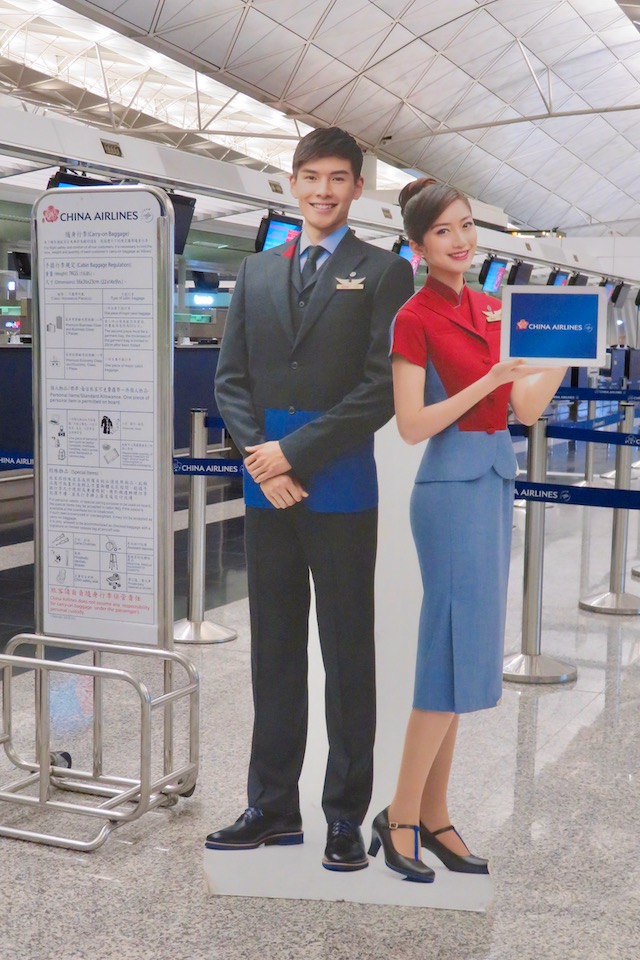

Apart from those in first class, there was no priority boarding. Passengers entered the aircraft depending on where they were sitting, with those at the rear called first. When our turn came we boarded and were confronted with row after row of empty seats. A few passengers wore disposable hazmat suits.
A friendly, chatty young flight attendant told us she had worn a similar suit on a flight to India. Before our flight she had spent 30 hours alone in her hotel room because of coronavirus restrictions. She said she had brought a lot of snacks to while away the time. Another attendant slipped me extra little bottles of red wine.
BA gets a lot of stick, but we were impressed with the crew. They seemed remarkably happy considering the problems their industry faces. Perhaps this was related to the previous day’s announcement that the chief executive was stepping down. In April, he had announced plans to cut 12,000 jobs and downgrade the terms and conditions of those who remained.
'Concentration Camp' Row
Another BA attendant had made a less good impression a couple of weeks before when she was confined to a quarantine centre in Hong Kong after a colleague tested positive. She sparked a diplomatic row by saying the conditions there were like “a literal concentration camp”.
We were told that our plane had been cleaned and sanitised before boarding. We were required to wear a mask throughout the trip, and had to provide our own. The only Covid protection provided by BA was a sachet of sanitiser and a hand wipe.
There was a coronavirus-related amendment to the pre-flight safety check – if we needed to use an oxygen mask in an emergency we were advised to remove our protective mask first. Passengers were asked to check that the toilet sign was green before using the facilities to prevent people standing close together in queues.
The flight went pretty well, and the lack of passengers meant it was possible to move around and stretch out. At Heathrow, we were told to exit in small groups, starting with those at the back. Heading through the airport, we were surprised to see a sign saying temperature screening systems were being tested as part of the response to Covid. This seemed a bit late, given that such checks been in widespread use not just at Hong Kong airport but in shops, hotels and restaurants across the city for many months.
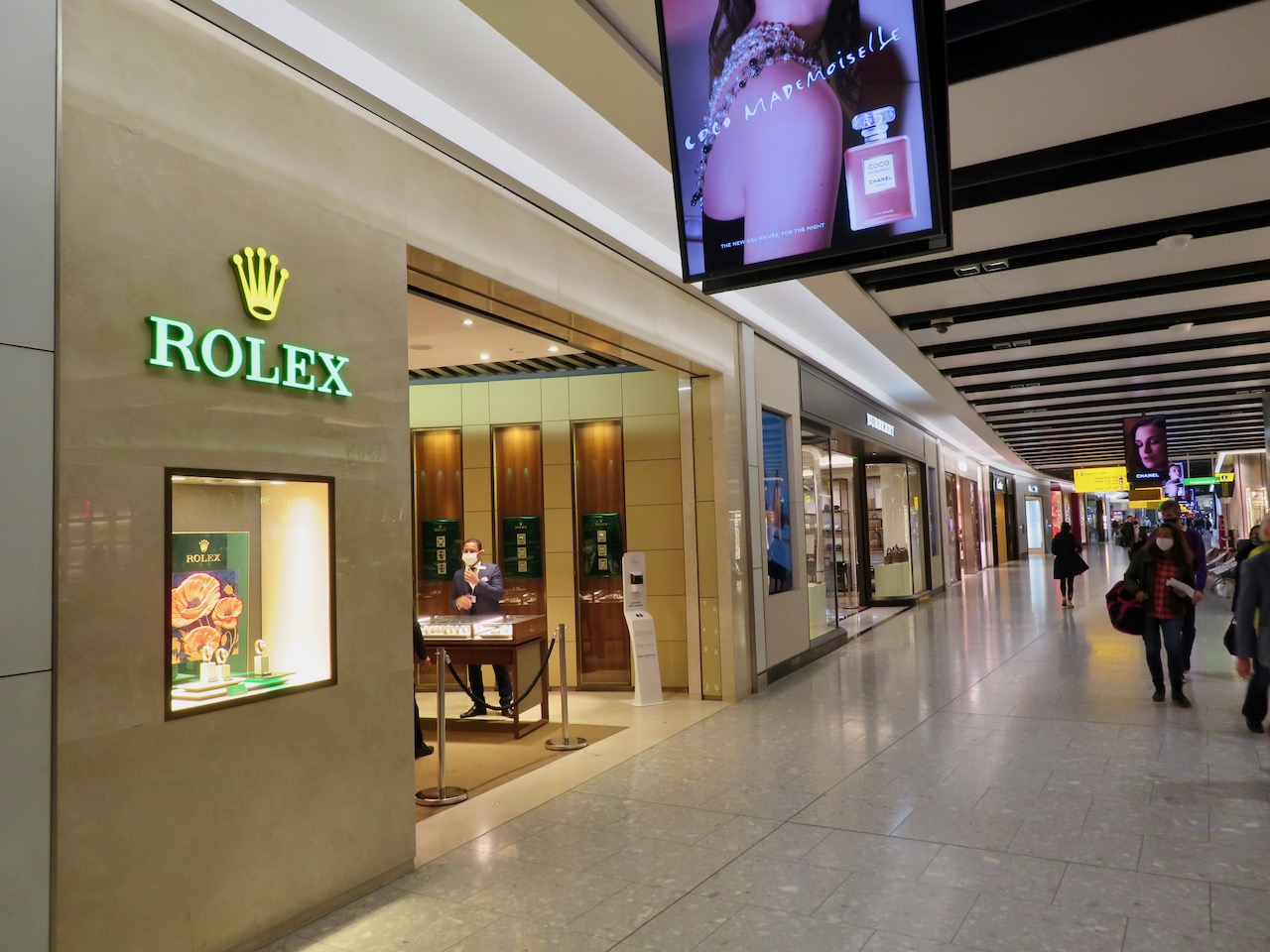
Terminal 5 at Heathrow was a very different story from Hong Kong. Bars and restaurants were open even though we landed around 5 a.m., as were the high-end shops and duty-free outlets. Some seats in waiting areas were out of use to maintain social distancing. Passenger numbers at Heathrow were down 84 percent in the peak summer months of July, August and September. However, the shortage of passengers was less striking in Terminal 5 than at Hong Kong, partly because of the distracting presence of all those glitzy shops.
We spoke to the manager of one restaurant, who said a decision had been made to show that Heathrow was once more open for business. The restaurant and others displayed a QR code on tables. The idea was that you scanned the code on your phone to access the menu. However, this did not work with the Heathrow WiFi service.
There was a similar situation on our second BA flight, to Faro in Portugal. We were told that the inflight shopping brochure and the High Life on-board magazine had gone online and could be accessed for free via WiFi. But we could not get this to work.
Contactless Strategy Undermined
In any case, this contactless strategy was rather undermined by the fact that the safety card was the old-fashioned cardboard type. The Faro flight was even quieter than the long-haul one. I counted 22 people at the gate waiting to board an Airbus A320 with room for up to 180. The Algarve is a popular winter destination because of its sunny climate, but the airport at Faro – though much, much smaller than the other two – was pretty quiet too.
While the low numbers are clearly disastrous for the airlines, it has to be said that they make for a better experience for passengers. It’s a worrying time to be travelling. But ironically the fact that so few are on the move, greatly reducing contact with others, makes it all seem pretty safe.
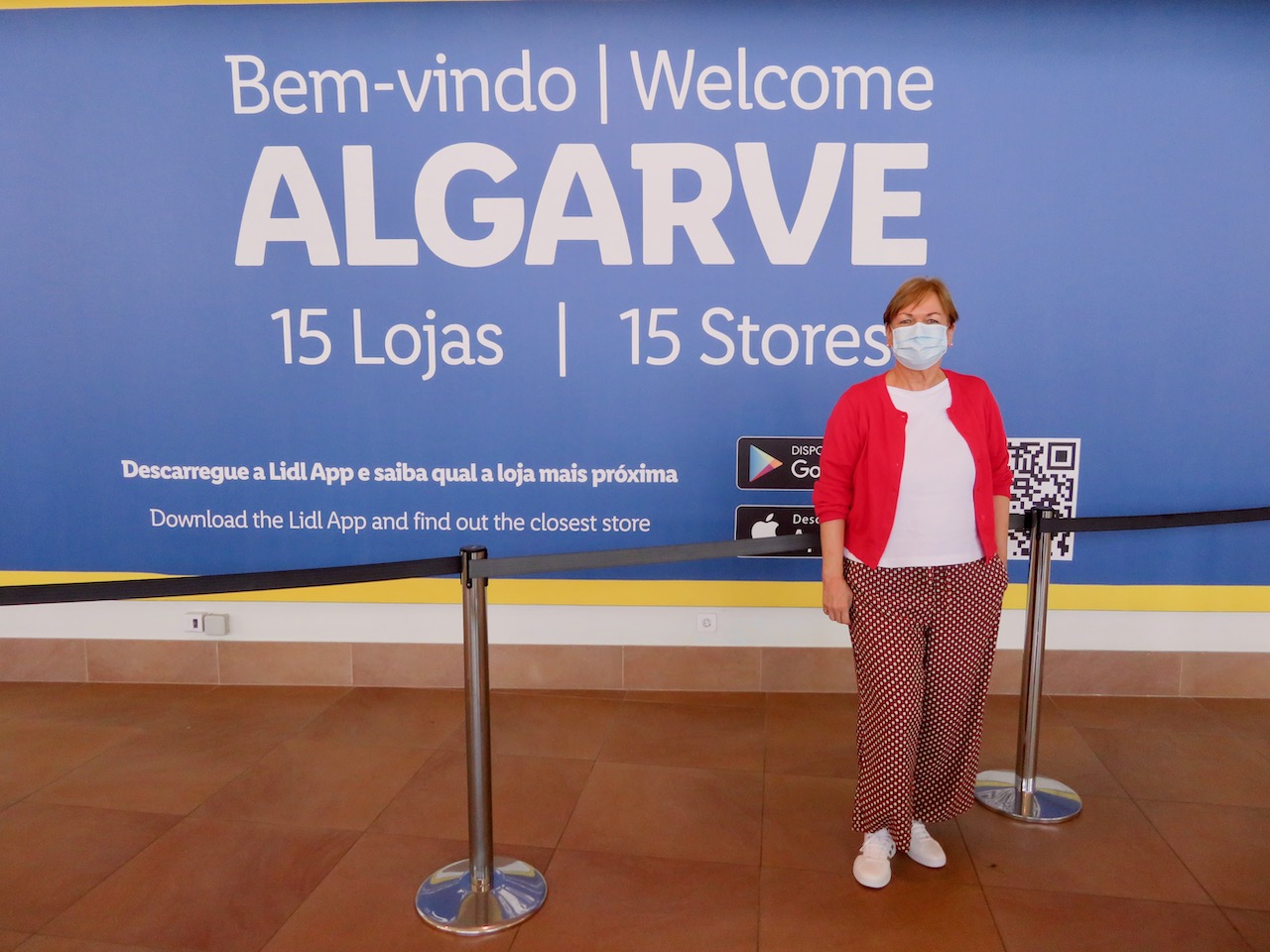
HAVE YOU flown recently? If so, we’d love to hear about your experiences of Covid-era travel – leave a comment below.
NOTE: We paid for this trip ourselves.
TOP PHOTO: Empty seats on our flight from Heathrow to Faro.
AFARANWIDE’S Sue Brattle has contributed to an online guide giving advice about travelling during the pandemic – READ MORE
Updated March 2021

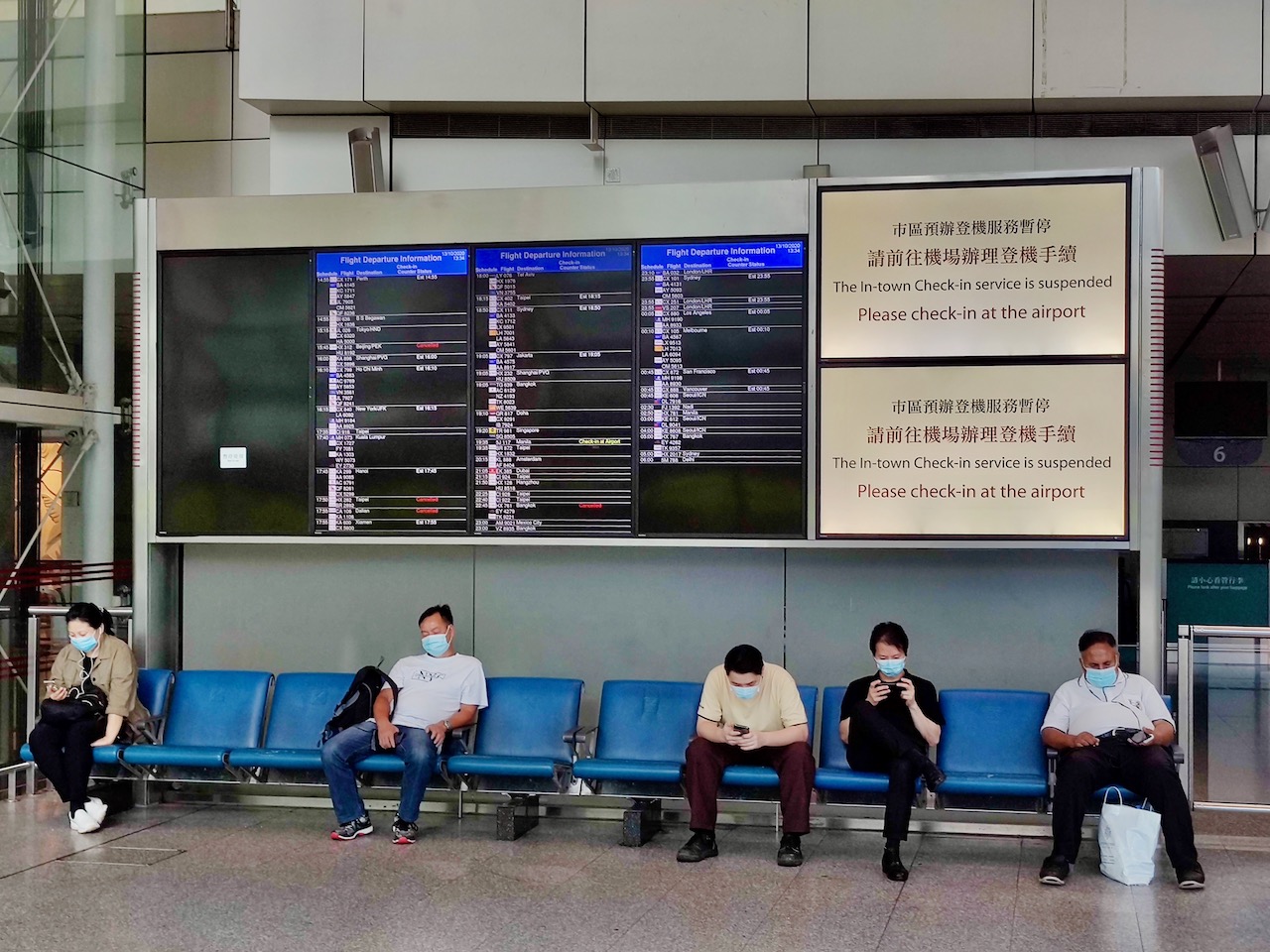

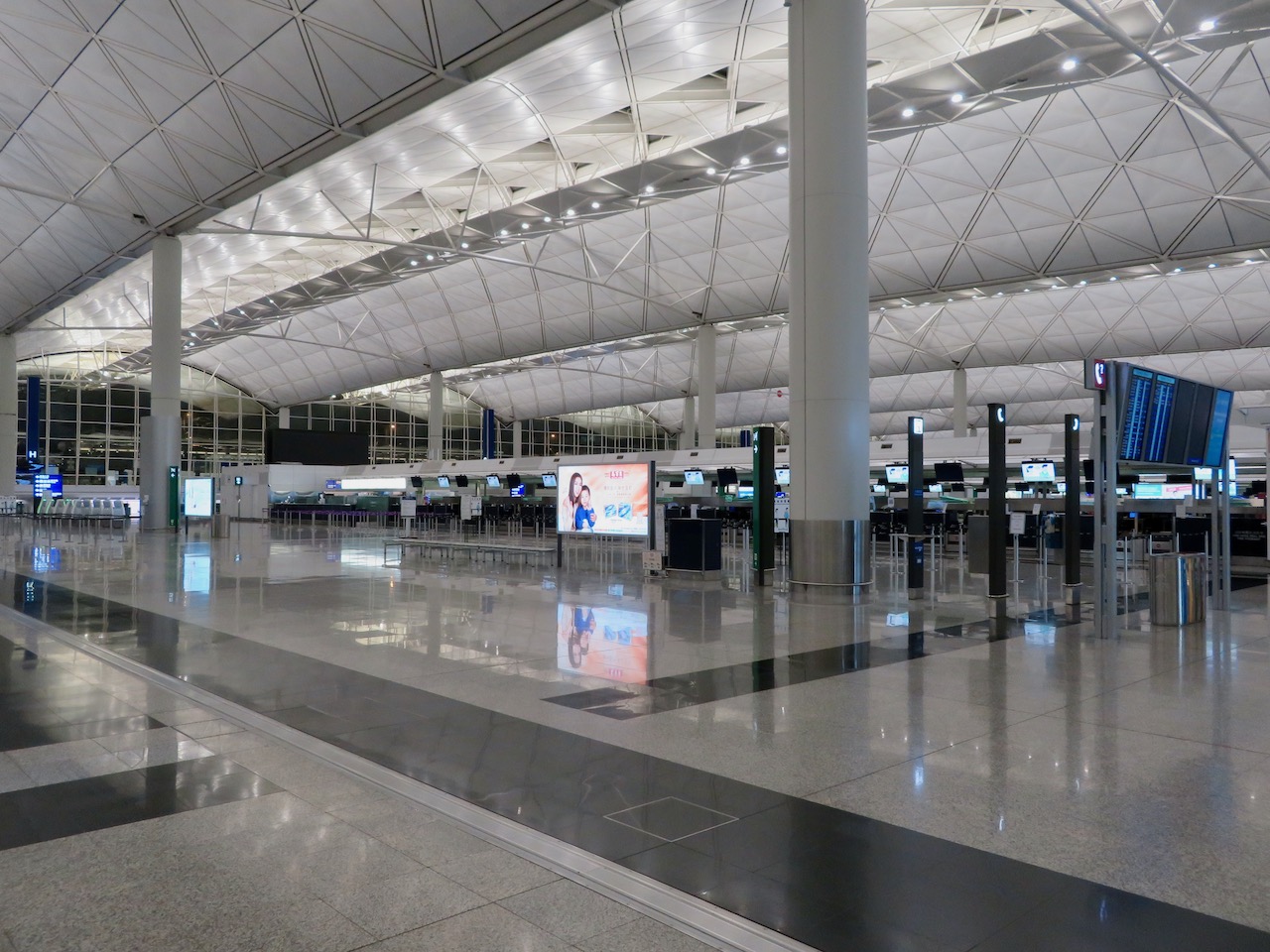
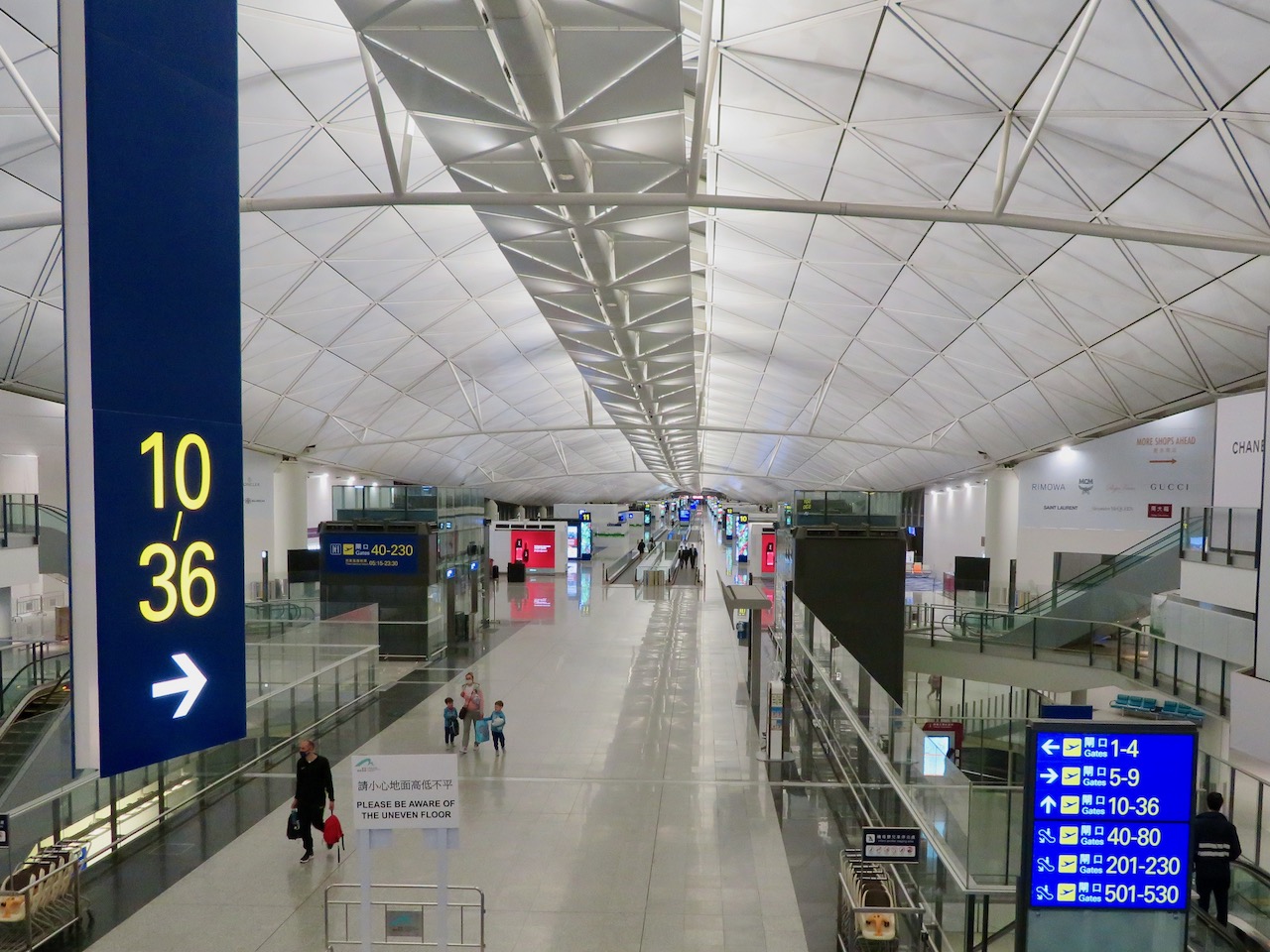

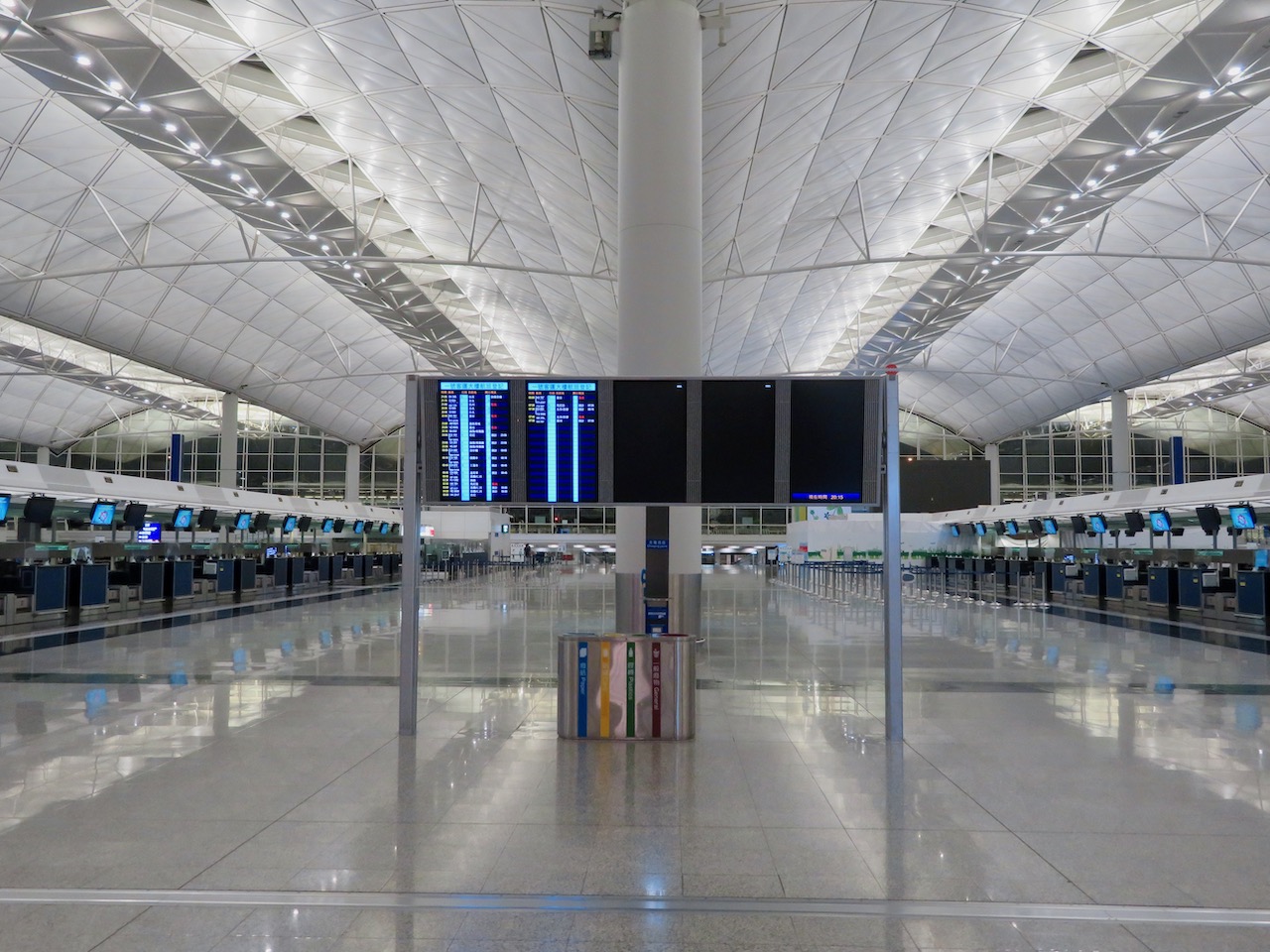

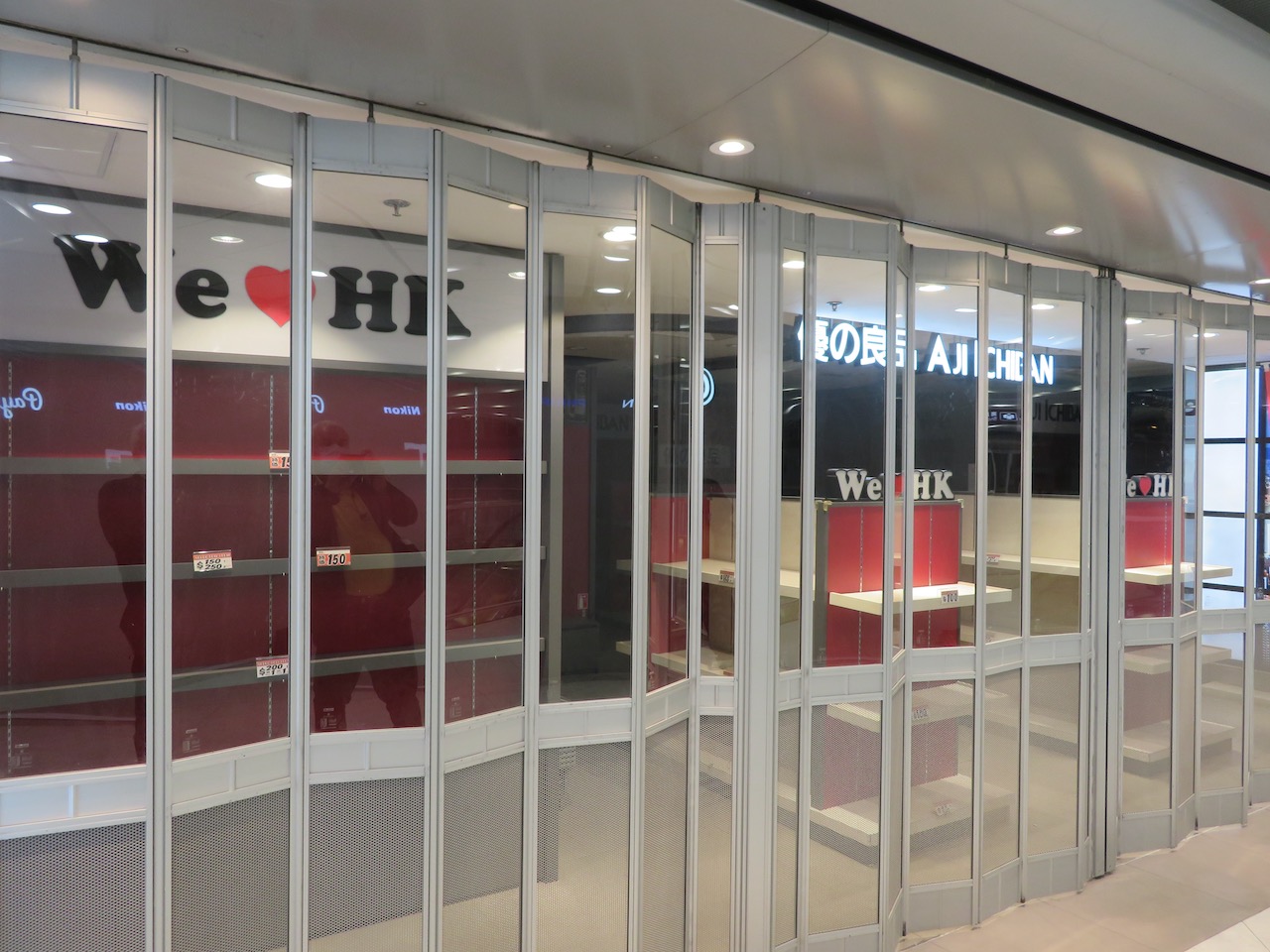
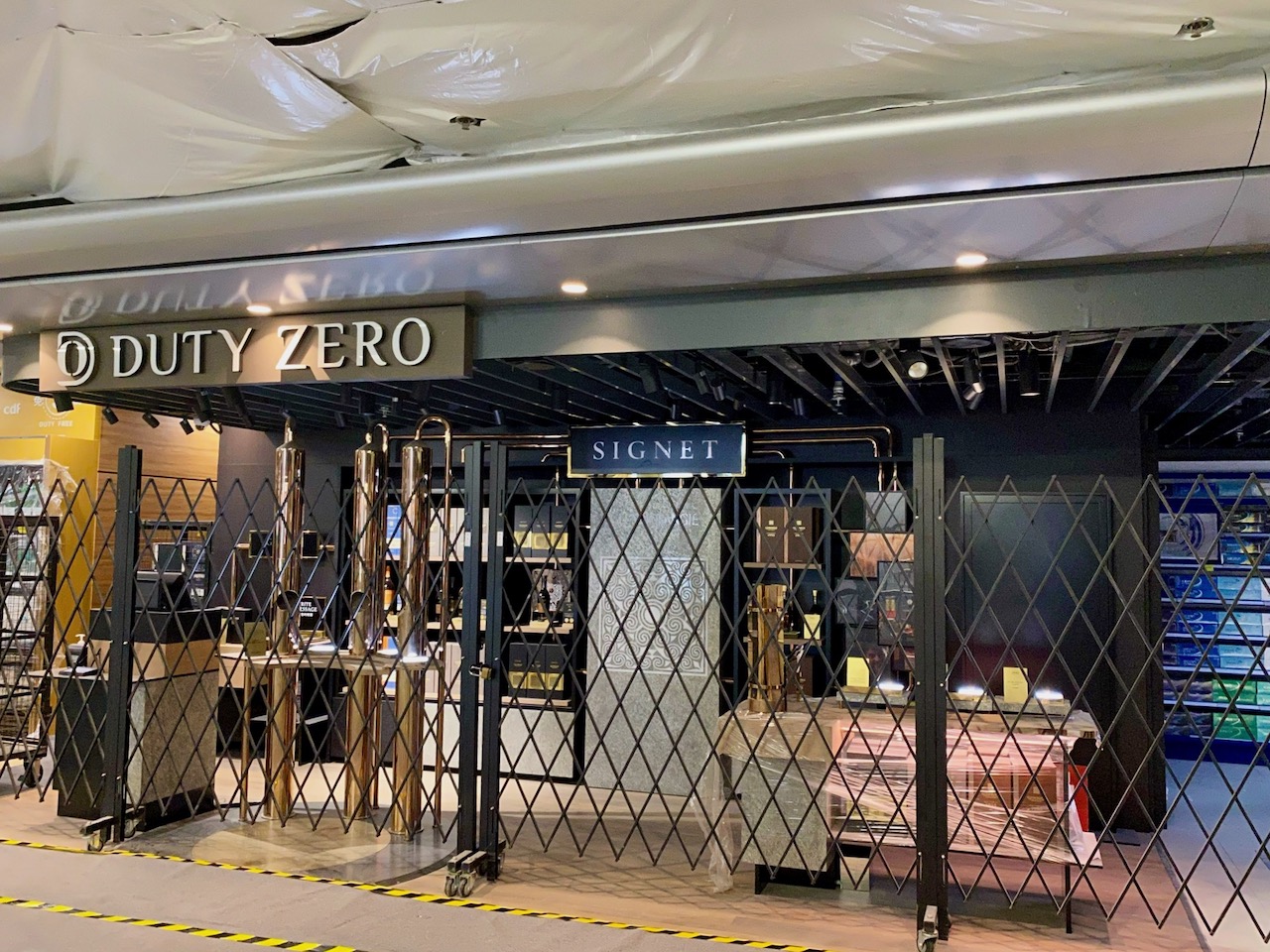
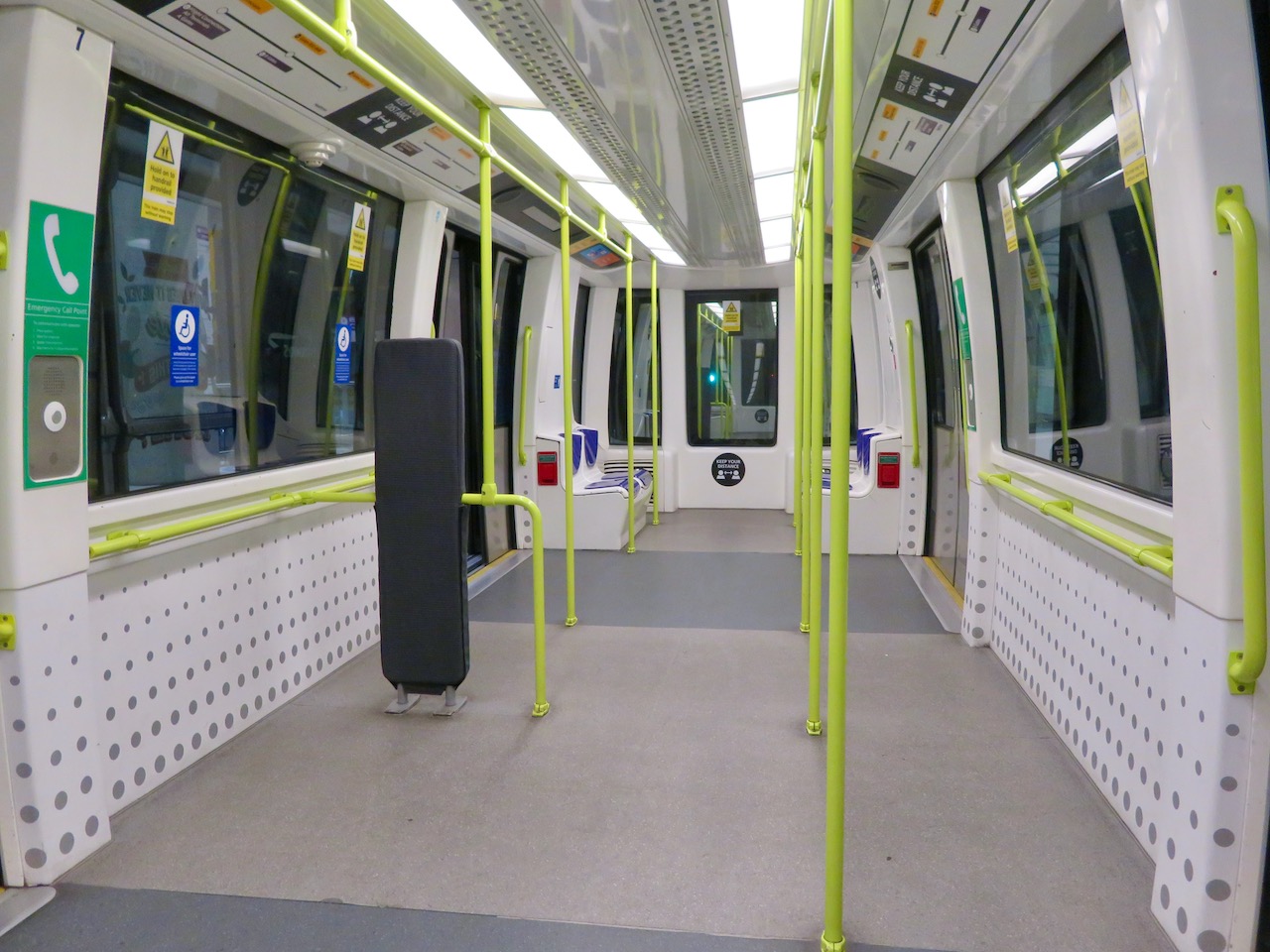
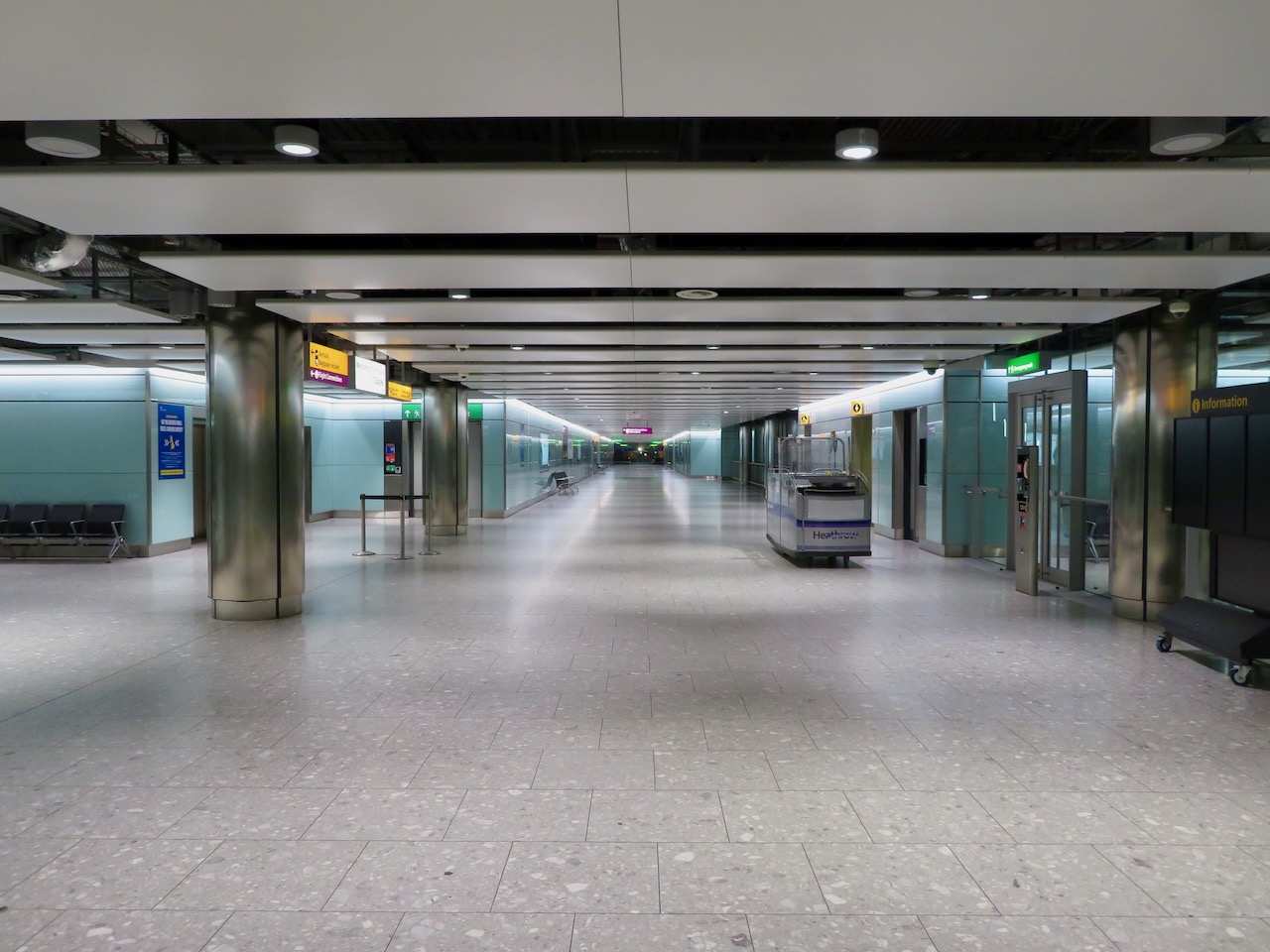
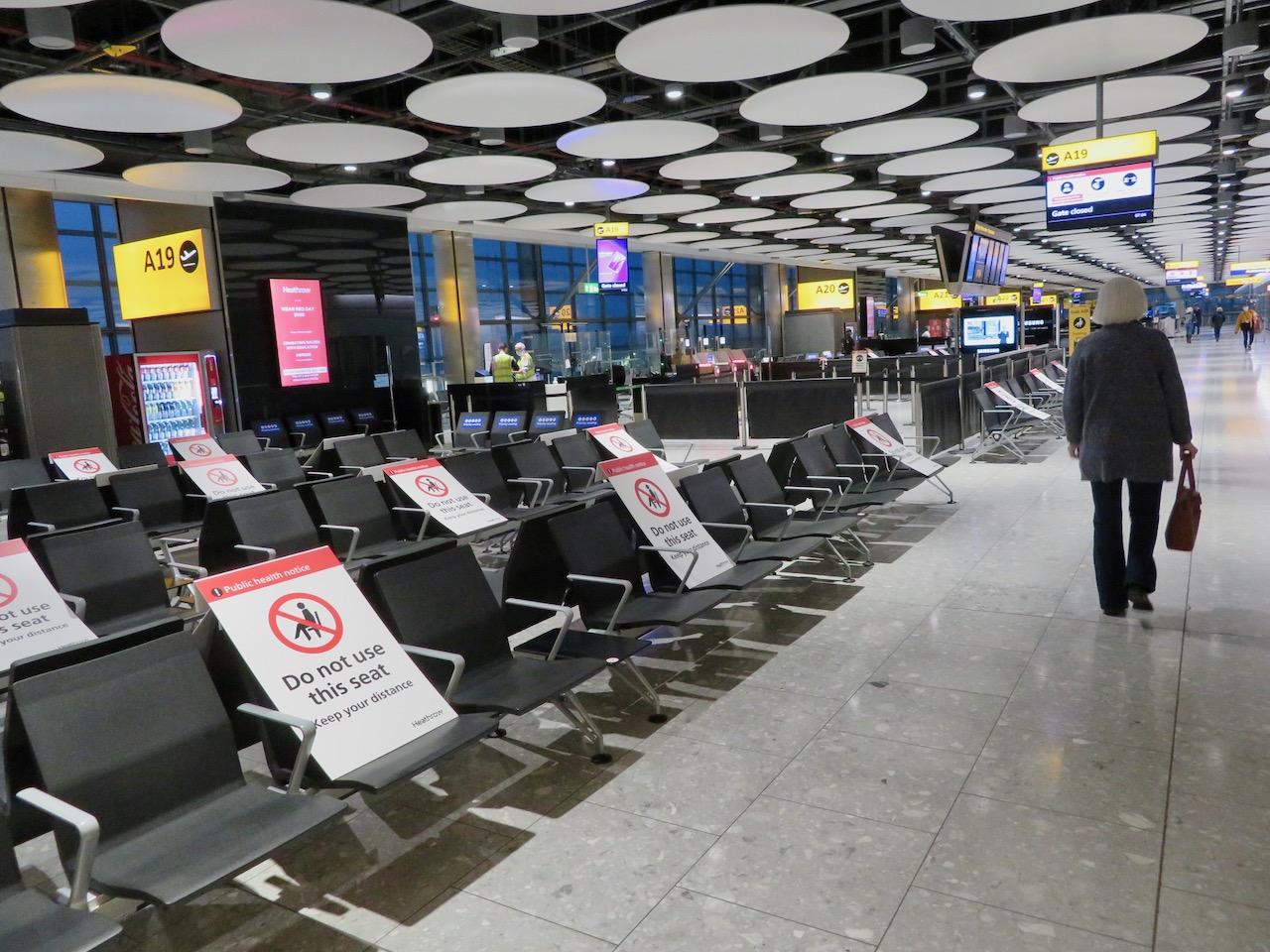
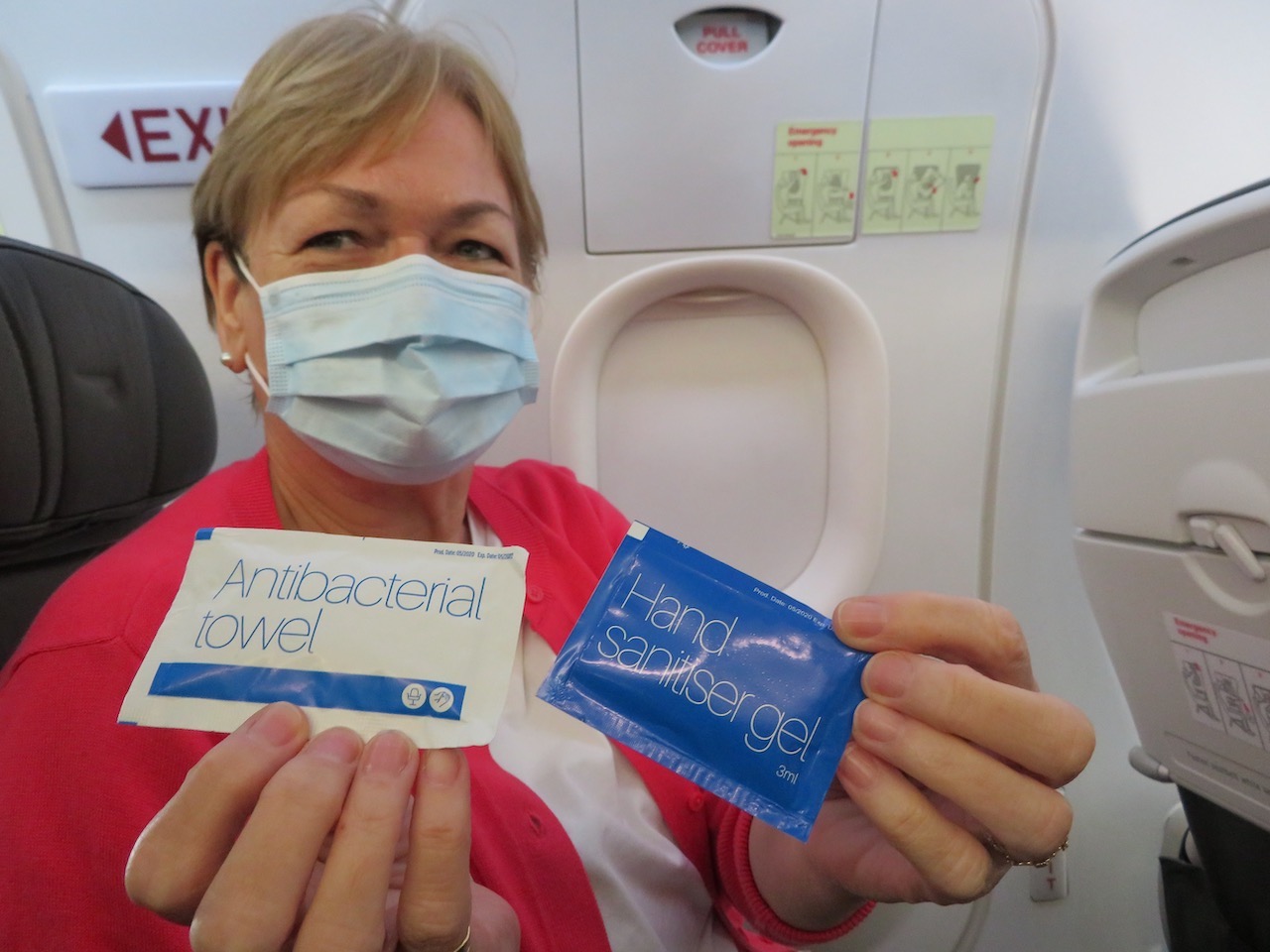
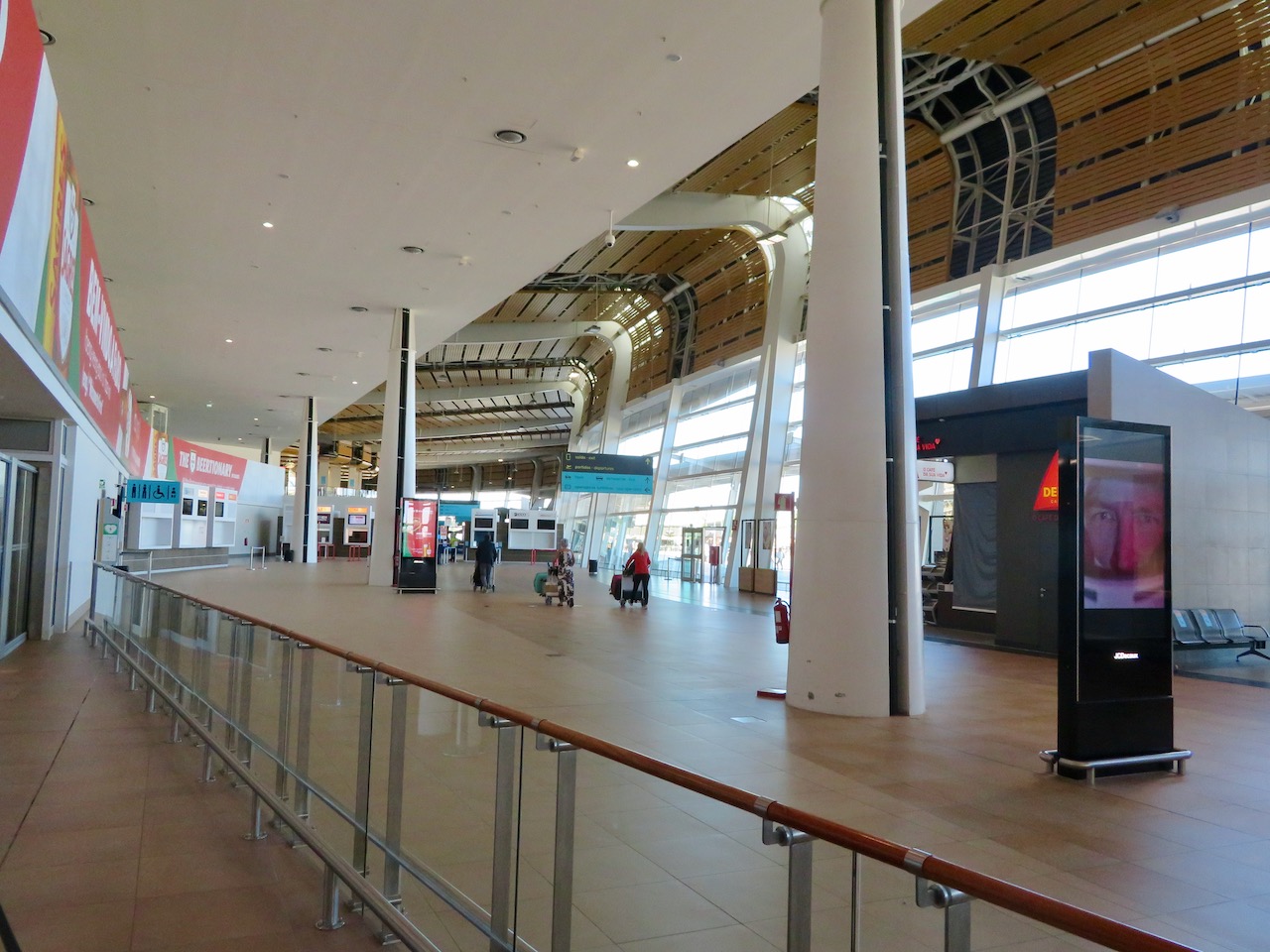
IN-FLIGHT MEAL, COVID STYLE
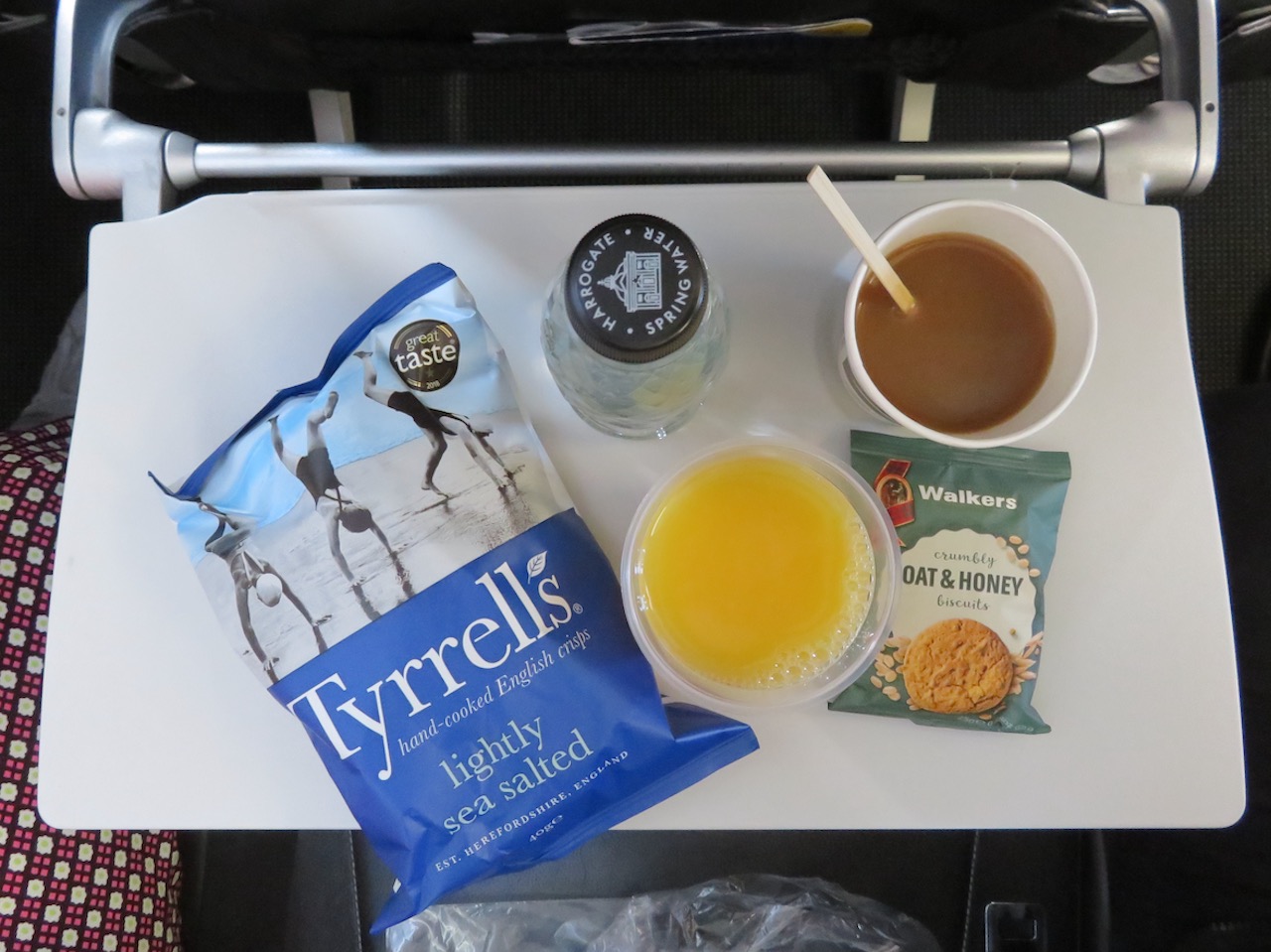
AIRLINES have amended their food offerings in response to Covid to reduce contact between passengers and cabin crew. On our British Airways premium economy flight from Hong Kong to Heathrow there was only one choice of main course, a couscous salad. Alcoholic and non-alcoholic drinks were served with the meal, but special meals and child meals are no longer offered.
Towards the end of the journey we were given a roll with vegetables in it. This was as dull as it sounds – the attendant who served it advised: “Don’t get too excited.”
The offering on our short-haul economy flight from Heathrow to Faro in Portugal was even more minimalist – a packet of crisps, a couple of biscuits, juice, coffee and water.
You’re free to take your own food on board, something I don’t remember airlines encouraging in the past. A couple of sandwiches from Terminal 5’s Pret et Manger kept us going on the three-hour flight.
Confusion Over UK Locator Form

PEOPLE arriving in the UK have to complete a “passenger locator form”. This enables the authorities to track them if someone they travelled with develops Covid symptoms. You fill in the form online up to 48 hours before arrival, and are sent a QR code by email. The code, which you print out or carry on your phone, is proof that you submitted the form.
The government website carries dire warnings about what happens to those who don’t complete it – they can be fined or refused entry to the country. Signs in airport arrivals areas carry similar messages. Yet when we transited through Heathrow we couldn’t find anyone to show the code to.
This raises the question of whether the form is required for transit passengers, something that’s not made clear on the website. A call to the government department involved ended the confusion. I was told transit passengers DO have to fill in the form, and there are spot checks on some of those passing through the airport. Checks are not carried out on everyone because this would cause queues to form at busy times.
Incidentally, submitting the form is easy and costs nothing. Avoid companies that seek to cash in on Covid by charging a fee to do it for you.
RELATED
 HOTELS DURING COVID: Is it safe to get a room? Here’s what we found when we stayed in two contrasting properties on different continents. READ MORE
HOTELS DURING COVID: Is it safe to get a room? Here’s what we found when we stayed in two contrasting properties on different continents. READ MORE
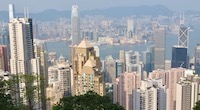 HOW HONG KONG IS TACKLING CORONAVIRUS: The city of skyscrapers is known as a bustling, noisy global metropolis. But how is it coping with COVID-19? READ MORE
HOW HONG KONG IS TACKLING CORONAVIRUS: The city of skyscrapers is known as a bustling, noisy global metropolis. But how is it coping with COVID-19? READ MORE
 HONG KONG DISNEYLAND has reopened with measures to combat Covid-19 in place. But is it still fun despite the restrictions? We find out. READ MORE
HONG KONG DISNEYLAND has reopened with measures to combat Covid-19 in place. But is it still fun despite the restrictions? We find out. READ MORE
 TOP 10 VIRTUAL ATTRACTIONS: Many of the world’s most popular tourists sites are closed because of the coronavirus crisis, but you can still visit them virtually while you’re self-isolating. READ MORE
TOP 10 VIRTUAL ATTRACTIONS: Many of the world’s most popular tourists sites are closed because of the coronavirus crisis, but you can still visit them virtually while you’re self-isolating. READ MORE
RECOMMENDED
 WELCOME TO OUR WORLD! Afaranwide’s home page – this is where you can find out about our latest posts and other highlights. READ MORE
WELCOME TO OUR WORLD! Afaranwide’s home page – this is where you can find out about our latest posts and other highlights. READ MORE
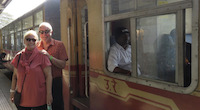 SHIMLA, QUEEN OF THE HILLS: Government officials once retreated to Shimla in the foothills of the Himalayas to escape India’s blazing hot summers. Now tourists make the same journey. READ MORE
SHIMLA, QUEEN OF THE HILLS: Government officials once retreated to Shimla in the foothills of the Himalayas to escape India’s blazing hot summers. Now tourists make the same journey. READ MORE
 TEN THINGS WE LEARNED: Our up-to-the-minute guide to creating a website, one step at a time. The costs, the mistakes – it’s what we wish we’d known when we started blogging. READ MORE
TEN THINGS WE LEARNED: Our up-to-the-minute guide to creating a website, one step at a time. The costs, the mistakes – it’s what we wish we’d known when we started blogging. READ MORE
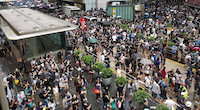 TROUBLED TIMES FOR EXPATS: Moving abroad can seem an idyllic prospect, but what happens when sudden upheavals or the inescapable realities of life intrude? READ MORE
TROUBLED TIMES FOR EXPATS: Moving abroad can seem an idyllic prospect, but what happens when sudden upheavals or the inescapable realities of life intrude? READ MORE
Disclosure: Afaranwide is an affiliate of leading travel operators such as Booking.com and Japan Rail Pass. If you purchase through our site we receive, at no additional cost to you, a small commission. We only work with companies we have used and recommend.
LET'S KEEP IN TOUCH!

COLIN SIMPSON
Passengers in Hazmat Suits, Empty Airports
and Planes… and Even Duty Free was Closed
WE ALL know air travel has been devastated by the coronavirus, but it’s still a shock when you’re flying during Covid and see the impact with your own eyes.
Before the pandemic, Hong Kong International Airport was one of the world’s busiest. In September last year, 4,857,000 international passengers passed through, according to official figures. And that was a time when tourist numbers had fallen because of violent clashes between anti-government protesters and the police. In September 2020, just 100,000 travellers used the airport – a 97.9 percent drop compared with the same month a year earlier.
So the scenes that greeted my wife Sue and I when we flew out of Hong Kong this month should hardly have been a surprise. But the wide, empty walkways and spaces, designed to move huge numbers of people swiftly and send them on their way, were still a shocking sight. Our passports and boarding cards were checked at the entrance to the terminal – a measure introduced last year to keep protesters out of the building. Our temperature was then measured before we were allowed in.


It was then that we first saw those vast deserted spaces. We had always associated HKG with crowds, the buzz and excitement of air travel, and that special pre-holiday sense of anticipation. Now it had become a ghost airport.
Many of the check-in areas were closed, and there were dramatically fewer flights than normal. Before Covid, the airport handled 68 flights per hour at peak times. When we arrived at Terminal 1 – one of the largest in the world – the departures board listed only 27 flights over the following 12 hours – and five of them had been cancelled. There seemed to be more staff than passengers. Some employees pushed lines of trolleys from one end of the empty departure hall to the other. I wouldn’t have been surprised if, when they reached the far end, they turned around and pushed them back. Though obviously I knew the reason for all this, I couldn’t stop myself instinctively wondering where everyone had gone.
Everything Looked Rather Shabby
The baggage drop and security checks were unchanged, though the process was much quicker because of the low number of passengers. When we reached the departure area we found most of the shops were closed, and some had clearly stopped trading. Some smaller shops had tarpaulins thrown over them. Even the duty-free shop was shut, and only a couple of the many restaurants were open. It was surprising how the absence of colourful and alluring products and crowds of people seemed to make everything look rather shabby.
We were flying to London Heathrow on a British Airways Boeing 777-300 in World Traveller Plus (ie premium economy). I counted about 50 people at the gate waiting to board a plane that can carry nearly 300.


Apart from those in first class, there was no priority boarding. Passengers entered the aircraft depending on where they were sitting, with those at the rear called first. When our turn came we boarded and were confronted with row after row of empty seats. A few passengers wore disposable hazmat suits.
A friendly, chatty young flight attendant told us she had worn a similar suit on a flight to India. Before our flight she had spent 30 hours alone in her hotel room because of coronavirus restrictions. She said she had brought a lot of snacks to while away the time. Another attendant slipped me extra little bottles of red wine.
BA gets a lot of stick, but we were impressed with the crew. They seemed remarkably happy considering the problems their industry faces. Perhaps this was related to the previous day’s announcement that the chief executive was stepping down. In April, he had announced plans to cut 12,000 jobs and downgrade the terms and conditions of those who remained.
'Concentration Camp' Row
Another BA attendant had made a less good impression a couple of weeks before when she was confined to a quarantine centre in Hong Kong after a colleague tested positive. She sparked a diplomatic row by saying the conditions there were like “a literal concentration camp”.
We were told that our plane had been cleaned and sanitised before boarding. We were required to wear a mask throughout the trip, and had to provide our own. The only Covid protection provided by BA was a sachet of sanitiser and a hand wipe.
There was a coronavirus-related amendment to the pre-flight safety check – if we needed to use an oxygen mask in an emergency we were advised to remove our protective mask first. Passengers were asked to check that the toilet sign was green before using the facilities to prevent people standing close together in queues.
The flight went pretty well, and the lack of passengers meant it was possible to move around and stretch out. At Heathrow, we were told to exit in small groups, starting with those at the back. Heading through the airport, we were surprised to see a sign saying temperature screening systems were being tested as part of the response to Covid. This seemed a bit late, given that such checks been in widespread use not just at Hong Kong airport but in shops, hotels and restaurants across the city for many months.

Terminal 5 at Heathrow was a very different story from Hong Kong. Bars and restaurants were open even though we landed around 5 a.m., as were the high-end shops and duty-free outlets. Some seats in waiting areas were out of use to maintain social distancing. Passenger numbers at Heathrow were down 84 percent in the peak summer months of July, August and September. However, the shortage of passengers was less striking in Terminal 5 than at Hong Kong, partly because of the distracting presence of all those glitzy shops.
We spoke to the manager of one restaurant, who said a decision had been made to show that Heathrow was once more open for business. The restaurant and others displayed a QR code on tables. The idea was that you scanned the code on your phone to access the menu. However, this did not work with the Heathrow WiFi service.
There was a similar situation on our second BA flight, to Faro in Portugal. We were told that the inflight shopping brochure and the High Life on-board magazine had gone online and could be accessed for free via WiFi. But we could not get this to work.
Contactless Strategy Undermined
In any case, this contactless strategy was rather undermined by the fact that the safety card was the old-fashioned cardboard type. The Faro flight was even quieter than the long-haul one. I counted 22 people at the gate waiting to board an Airbus A320 with room for up to 180. The Algarve is a popular winter destination because of its sunny climate, but the airport at Faro – though much, much smaller than the other two – was pretty quiet too.
While the low numbers are clearly disastrous for the airlines, it has to be said that they make for a better experience for passengers. It’s a worrying time to be travelling. But ironically the fact that so few are on the move, greatly reducing contact with others, makes it all seem pretty safe.

HAVE YOU flown recently? If so, we’d love to hear about your experiences of Covid-era travel – leave a comment below.
NOTE: We paid for this trip ourselves.
TOP PHOTO: Empty seats on our flight from Heathrow to Faro.
AFARANWIDE’S Sue Brattle has contributed to an online guide giving advice about travelling during the pandemic – READ MORE
Updated March 2021















IN-FLIGHT MEAL, COVID STYLE

AIRLINES have amended their food offerings in response to Covid to reduce contact between passengers and cabin crew. On our British Airways premium economy flight from Hong Kong to Heathrow there was only one choice of main course, a couscous salad. Alcoholic and non-alcoholic drinks were served with the meal, but special meals and child meals are no longer offered.
Towards the end of the journey we were given a roll with vegetables in it. This was as dull as it sounds – the attendant who served it advised: “Don’t get too excited.”
The offering on our short-haul economy flight from Heathrow to Faro in Portugal was even more minimalist – a packet of crisps, a couple of biscuits, juice, coffee and water.
You’re free to take your own food on board, something I don’t remember airlines encouraging in the past. A couple of sandwiches from Terminal 5’s Pret et Manger kept us going on the three-hour flight.
Confusion Over UK Locator Form

PEOPLE arriving in the UK have to complete a “passenger locator form”. This enables the authorities to track them if someone they travelled with develops Covid symptoms. You fill in the form online up to 48 hours before arrival, and are sent a QR code by email. The code, which you print out or carry on your phone, is proof that you submitted the form.
The government website carries dire warnings about what happens to those who don’t complete it – they can be fined or refused entry to the country. Signs in airport arrivals areas carry similar messages. Yet when we transited through Heathrow we couldn’t find anyone to show the code to.
This raises the question of whether the form is required for transit passengers, something that’s not made clear on the website. A call to the government department involved ended the confusion. I was told transit passengers DO have to fill in the form, and there are spot checks on some of those passing through the airport. Checks are not carried out on everyone because this would cause queues to form at busy times.
Incidentally, submitting the form is easy and costs nothing. Avoid companies that seek to cash in on Covid by charging a fee to do it for you.
RELATED
 HOTELS DURING COVID: Is it safe to get a room? Here’s what we found when we stayed in two contrasting properties on different continents. READ MORE
HOTELS DURING COVID: Is it safe to get a room? Here’s what we found when we stayed in two contrasting properties on different continents. READ MORE
 HOW HONG KONG IS TACKLING CORONAVIRUS: The city of skyscrapers is known as a bustling, noisy global metropolis. But how is it coping with COVID-19? READ MORE
HOW HONG KONG IS TACKLING CORONAVIRUS: The city of skyscrapers is known as a bustling, noisy global metropolis. But how is it coping with COVID-19? READ MORE
 HONG KONG DISNEYLAND has reopened with measures to combat Covid-19 in place. But is it still fun despite the restrictions? We find out. READ MORE
HONG KONG DISNEYLAND has reopened with measures to combat Covid-19 in place. But is it still fun despite the restrictions? We find out. READ MORE
 TOP 10 VIRTUAL ATTRACTIONS: Many of the world’s most popular tourists sites are closed because of the coronavirus crisis, but you can still visit them virtually while you’re self-isolating. READ MORE
TOP 10 VIRTUAL ATTRACTIONS: Many of the world’s most popular tourists sites are closed because of the coronavirus crisis, but you can still visit them virtually while you’re self-isolating. READ MORE
RECOMMENDED
 WELCOME TO OUR WORLD! Afaranwide’s home page – this is where you can find out about our latest posts and other highlights. READ MORE
WELCOME TO OUR WORLD! Afaranwide’s home page – this is where you can find out about our latest posts and other highlights. READ MORE
 SHIMLA, QUEEN OF THE HILLS: Government officials once retreated to Shimla in the foothills of the Himalayas to escape India’s blazing hot summers. Now tourists make the same journey. READ MORE
SHIMLA, QUEEN OF THE HILLS: Government officials once retreated to Shimla in the foothills of the Himalayas to escape India’s blazing hot summers. Now tourists make the same journey. READ MORE
 TEN THINGS WE LEARNED: Our up-to-the-minute guide to creating a website, one step at a time. The costs, the mistakes – it’s what we wish we’d known when we started blogging. READ MORE
TEN THINGS WE LEARNED: Our up-to-the-minute guide to creating a website, one step at a time. The costs, the mistakes – it’s what we wish we’d known when we started blogging. READ MORE
 TROUBLED TIMES FOR EXPATS: Moving abroad can seem an idyllic prospect, but what happens when sudden upheavals or the inescapable realities of life intrude? READ MORE
TROUBLED TIMES FOR EXPATS: Moving abroad can seem an idyllic prospect, but what happens when sudden upheavals or the inescapable realities of life intrude? READ MORE
Disclosure: Afaranwide is an affiliate of leading travel operators such as Booking.com and Japan Rail Pass. If you purchase through our site we receive, at no additional cost to you, a small commission. We only work with companies we have used and recommend.
LET'S KEEP IN TOUCH!
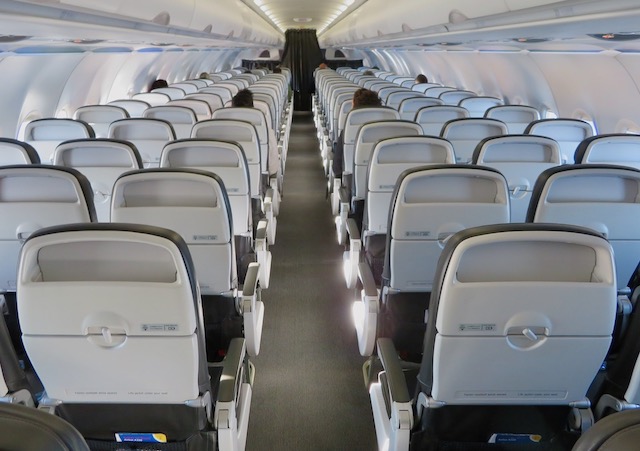
Flying During COVID
Passengers in Hazmat Suits, Empty Airports and Planes… and Even Duty Free was Closed

COLIN SIMPSON
WE ALL know air travel has been devastated by the coronavirus, but it’s still a shock when you’re flying during Covid and see the impact with your own eyes.
Before the pandemic, Hong Kong International Airport was one of the world’s busiest. In September last year, 4,857,000 international passengers passed through, according to official figures.
And that was a time when tourist numbers had fallen because of violent clashes between anti-government protesters and the police. In September 2020, just 100,000 travellers used the airport – a 97.9 percent drop compared with the same month a year earlier.
So the scenes that greeted my wife Sue and I when we flew out of Hong Kong this month should hardly have been a surprise. But the wide, empty walkways and spaces, designed to move huge numbers of people swiftly and send them on their way, were still a shocking sight.
Our passports and boarding cards were checked at the entrance to the terminal – a measure introduced last year to keep protesters out of the building. Our temperature was then measured before we were allowed in.


It was then that we first saw those vast deserted spaces. We had always associated HKG with crowds, the buzz and excitement of air travel, and that special pre-holiday sense of anticipation. Now it had become a ghost airport.
Many of the check-in areas were closed, and there were dramatically fewer flights than normal. Before Covid, the airport handled 68 flights per hour at peak times. When we arrived at Terminal 1 – one of the largest in the world – the departures board listed only 27 flights over the following 12 hours – and five of them had been cancelled.
There seemed to be more staff than passengers. Some employees pushed lines of trolleys from one end of the empty departure hall to the other. I wouldn’t have been surprised if, when they reached the far end, they turned around and pushed them back. Though obviously I knew the reason for all this, I couldn’t stop myself instinctively wondering where everyone had gone.
Everything Looked Rather Shabby
The baggage drop and security checks were unchanged, though the process was much quicker because of the low number of passengers. When we reached the departure area we found most of the shops were closed, and some had clearly stopped trading. Some smaller shops had tarpaulins thrown over them.
Even the duty-free shop was shut, and only a couple of the many restaurants were open. It was surprising how the absence of colourful and alluring products and crowds of people seemed to make everything look rather shabby.
We were flying to London Heathrow on a British Airways Boeing 777-300 in World Traveller Plus (ie premium economy). I counted about 50 people at the gate waiting to board a plane that can carry nearly 300.

Apart from those in first class, there was no priority boarding. Passengers entered the aircraft depending on where they were sitting, with those at the rear called first. When our turn came we boarded and were confronted with row after row of empty seats. A few passengers wore disposable hazmat suits.
A friendly, chatty young flight attendant told us she had worn a similar suit on a flight to India. Before our flight she had spent 30 hours alone in her hotel room because of coronavirus restrictions. She said she had brought a lot of snacks to while away the time. Another attendant slipped me extra little bottles of red wine.
BA gets a lot of stick, but we were impressed with the crew. They seemed remarkably happy considering the problems their industry faces. Perhaps this was related to the previous day’s announcement that the chief executive was stepping down. In April, he had announced plans to cut 12,000 jobs and downgrade the terms and conditions of those who remained.
'Concentration Camp' Row
Another BA attendant had made a less good impression a couple of weeks before when she was confined to a quarantine centre in Hong Kong after a colleague tested positive. She sparked a diplomatic row by saying the conditions there were like “a literal concentration camp”.
We were told that our plane had been cleaned and sanitised before boarding. We were required to wear a mask throughout the trip, and had to provide our own. The only Covid protection provided by BA was a sachet of sanitiser and a hand wipe.
There was a coronavirus-related amendment to the pre-flight safety check – if we needed to use an oxygen mask in an emergency we were advised to remove our protective mask first. Passengers were asked to check that the toilet sign was green before using the facilities to prevent people standing close together in queues.
The flight went pretty well, and the lack of passengers meant it was possible to move around and stretch out. At Heathrow, we were told to exit in small groups, starting with those at the back.
Heading through the airport, we were surprised to see a sign saying temperature screening systems were being tested as part of the response to Covid. This seemed a bit late, given that such checks been in widespread use not just at Hong Kong airport but in shops, hotels and restaurants across the city for many months.

Terminal 5 at Heathrow was a very different story from Hong Kong. Bars and restaurants were open even though we landed around 5 a.m., as were the high-end shops and duty-free outlets. Some seats in waiting areas were out of use to maintain social distancing.
Passenger numbers at Heathrow were down 84 percent in the peak summer months of July, August and September. However, the shortage of passengers was less striking in Terminal 5 than at Hong Kong, partly because of the distracting presence of all those glitzy shops.
We spoke to the manager of one restaurant, who said a decision had been made to show that Heathrow was once more open for business. The restaurant and others displayed a QR code on tables. The idea was that you scanned the code on your phone to access the menu. However, this did not work with the Heathrow WiFi service.
There was a similar situation on our second BA flight, to Faro in Portugal. We were told that the inflight shopping brochure and the High Life on-board magazine had gone online and could be accessed for free via WiFi. But we could not get this to work.
Contactless Strategy Undermined
In any case, this contactless strategy was rather undermined by the fact that the safety card was the old-fashioned cardboard type. The Faro flight was even quieter than the long-haul one. I counted 22 people at the gate waiting to board an Airbus A320 with room for up to 180. The Algarve is a popular winter destination because of its sunny climate, but the airport at Faro – though much, much smaller than the other two – was pretty quiet too.
While the low numbers are clearly disastrous for the airlines, it has to be said that they make for a better experience for passengers. It’s a worrying time to be travelling.
But ironically the fact that so few are on the move, greatly reducing contact with others, makes it all seem pretty safe.
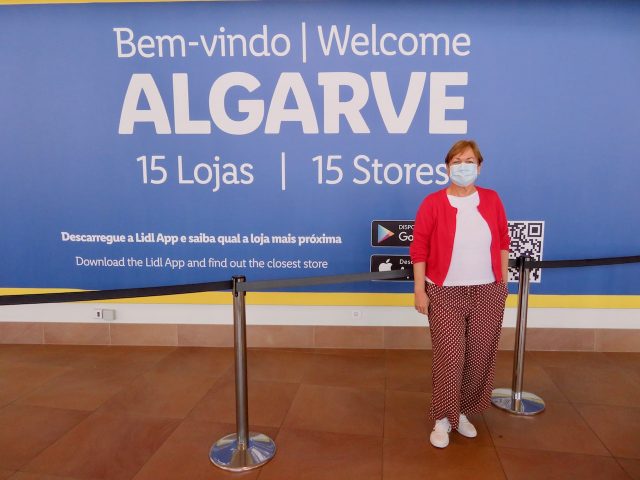
HAVE YOU flown recently? If so, we’d love to hear about your experiences of Covid-era travel – leave a comment below.
NOTE: We paid for this trip ourselves.
TOP PHOTO: Empty seats on our flight from Heathrow to Faro.
AFARANWIDE’S Sue Brattle has contributed to an online guide giving advice about travelling during the pandemic – READ MORE
Updated March 2021


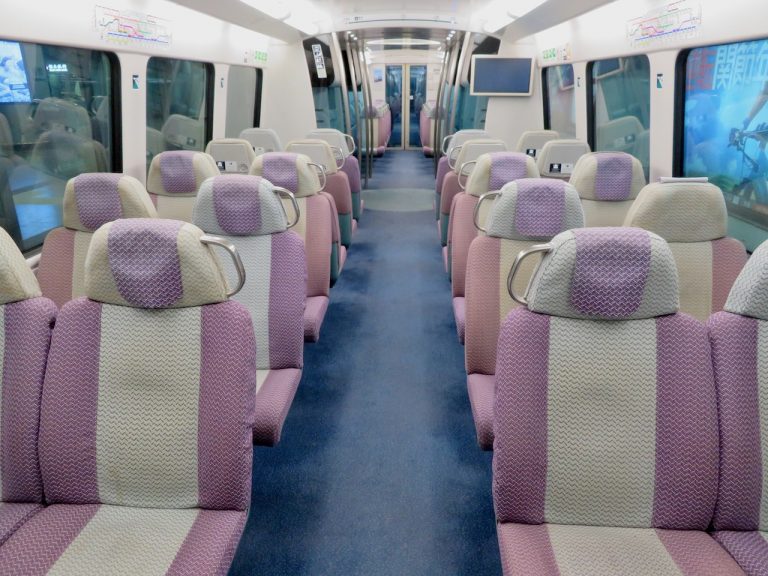
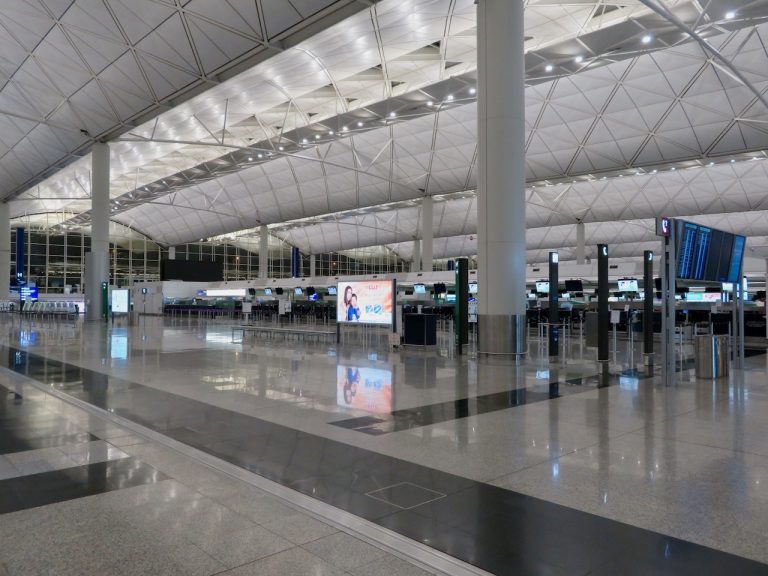
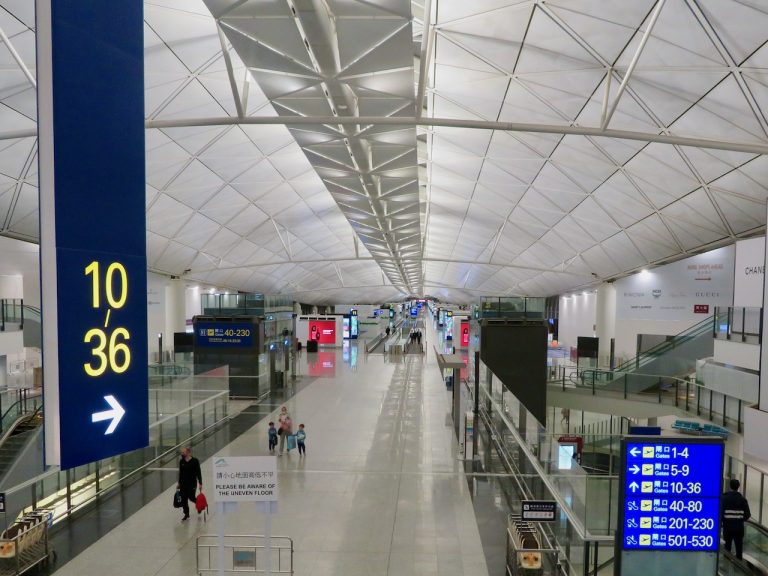
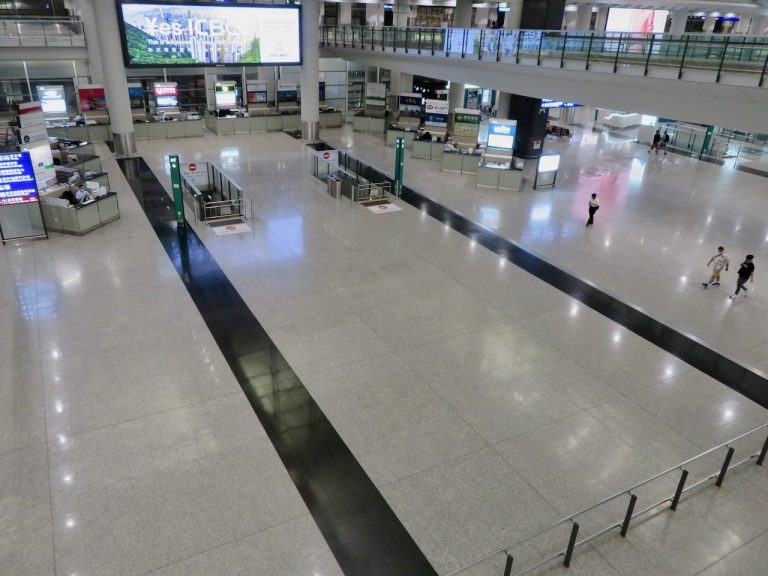
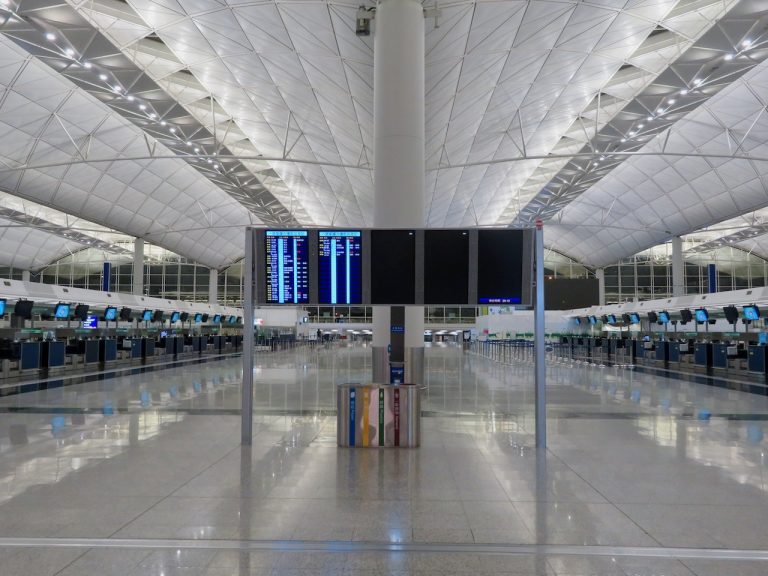
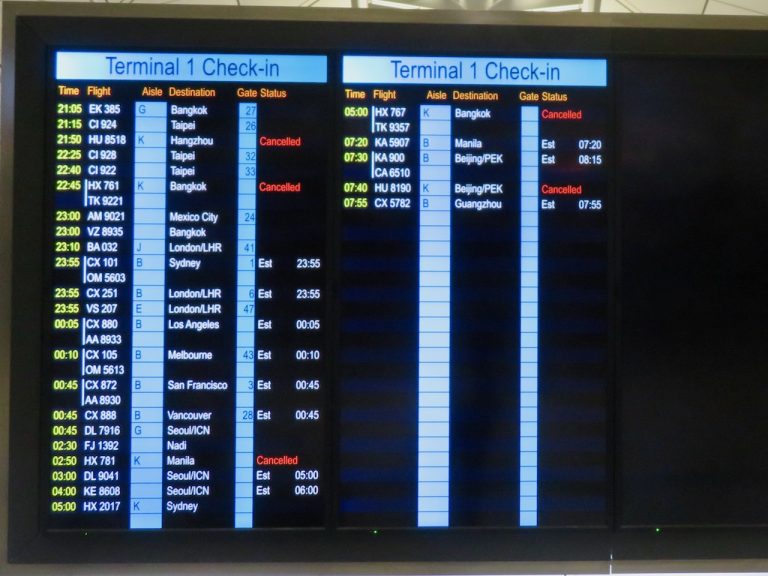

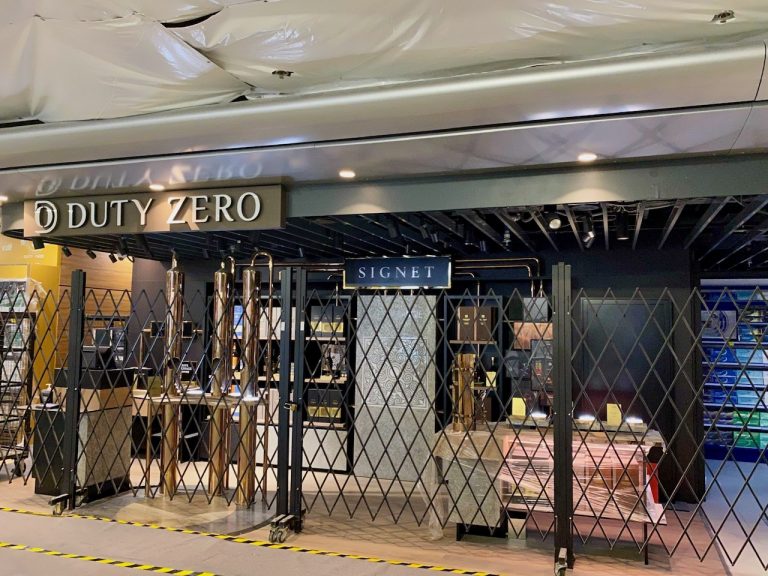
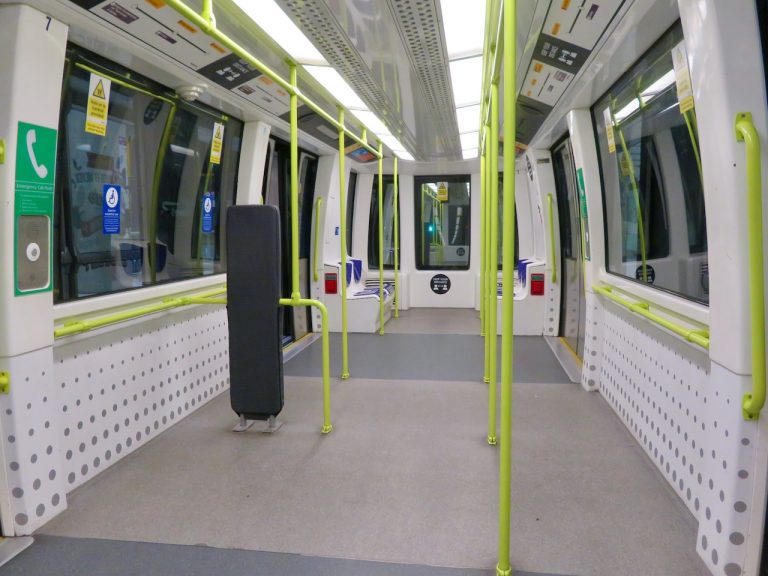

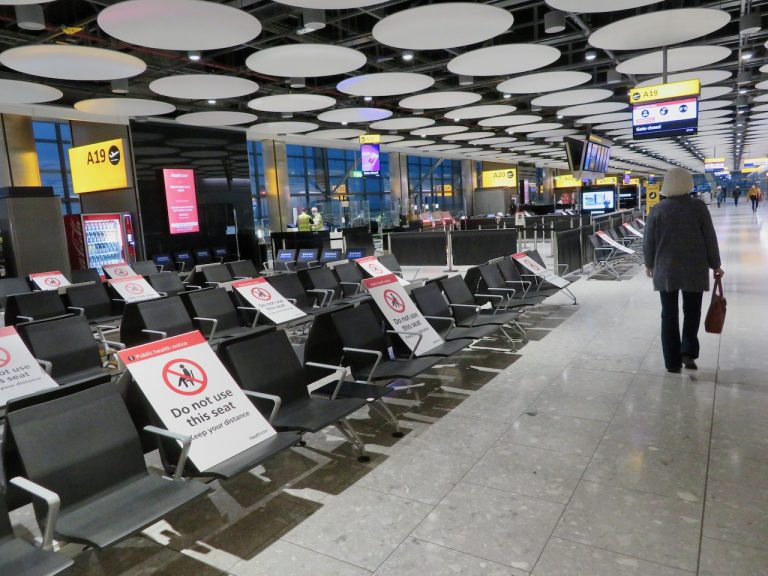
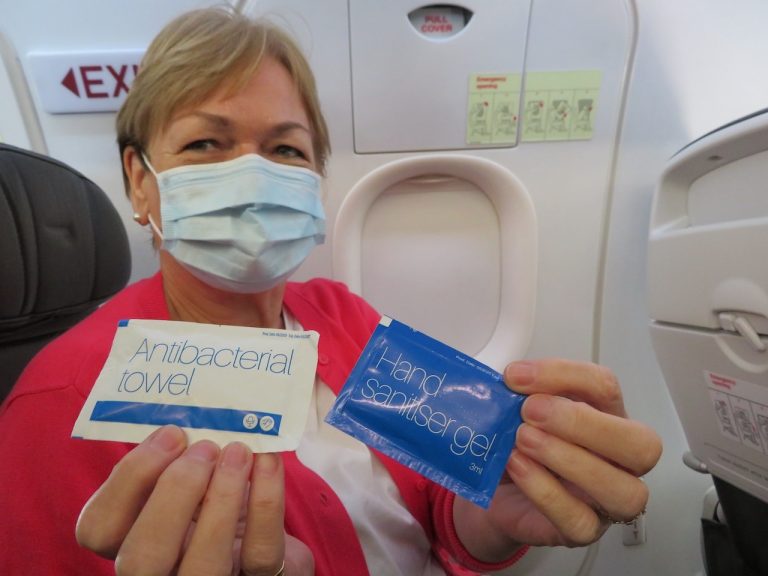

IN-FLIGHT MEAL, COVID STYLE

AIRLINES have amended their food offerings in response to Covid to reduce contact between passengers and cabin crew. On our British Airways premium economy flight from Hong Kong to Heathrow there was only one choice of main course, a couscous salad. Alcoholic and non-alcoholic drinks were served with the meal, but special meals and child meals are no longer offered.
Towards the end of the journey we were given a roll with vegetables in it. This was as dull as it sounds – the attendant who served it advised: “Don’t get too excited.”
The offering on our short-haul economy flight from Heathrow to Faro in Portugal was even more minimalist – a packet of crisps, a couple of biscuits, juice, coffee and water.
You’re free to take your own food on board, something I don’t remember airlines encouraging in the past. A couple of sandwiches from Terminal 5’s Pret et Manger kept us going on the three-hour flight.
Confusion Over UK Locator Form

PEOPLE arriving in the UK have to complete a “passenger locator form”. This enables the authorities to track them if someone they travelled with develops Covid symptoms. You fill in the form online up to 48 hours before arrival, and are sent a QR code by email. The code, which you print out or carry on your phone, is proof that you submitted the form.
The government website carries dire warnings about what happens to those who don’t complete it – they can be fined or refused entry to the country. Signs in airport arrivals areas carry similar messages. Yet when we transited through Heathrow we couldn’t find anyone to show the code to.
This raises the question of whether the form is required for transit passengers, something that’s not made clear on the website. A call to the government department involved ended the confusion. I was told transit passengers DO have to fill in the form, and there are spot checks on some of those passing through the airport. Checks are not carried out on everyone because this would cause queues to form at busy times.
Incidentally, submitting the form is easy and costs nothing. Avoid companies that seek to cash in on Covid by charging a fee to do it for you.
RELATED
 HOTELS DURING COVID: Is it safe to get a room? Here’s what we found when we stayed in two contrasting properties on different continents. READ MORE
HOTELS DURING COVID: Is it safe to get a room? Here’s what we found when we stayed in two contrasting properties on different continents. READ MORE
 HOW HONG KONG IS TACKLING CORONAVIRUS: The city of skyscrapers is known as a bustling, noisy global metropolis. But how is it coping with COVID-19? READ MORE
HOW HONG KONG IS TACKLING CORONAVIRUS: The city of skyscrapers is known as a bustling, noisy global metropolis. But how is it coping with COVID-19? READ MORE
 HONG KONG DISNEYLAND has reopened with measures to combat Covid-19 in place. But is it still fun despite the restrictions? We find out. READ MORE
HONG KONG DISNEYLAND has reopened with measures to combat Covid-19 in place. But is it still fun despite the restrictions? We find out. READ MORE
 TOP 10 VIRTUAL ATTRACTIONS: Many of the world’s most popular tourists sites are closed because of the coronavirus crisis, but you can still visit them virtually while you’re self-isolating. READ MORE
TOP 10 VIRTUAL ATTRACTIONS: Many of the world’s most popular tourists sites are closed because of the coronavirus crisis, but you can still visit them virtually while you’re self-isolating. READ MORE
RECOMMENDED
 WELCOME TO OUR WORLD! Afaranwide’s home page – this is where you can find out about our latest posts and other highlights. READ MORE
WELCOME TO OUR WORLD! Afaranwide’s home page – this is where you can find out about our latest posts and other highlights. READ MORE
 SHIMLA, QUEEN OF THE HILLS: Government officials once retreated to Shimla in the foothills of the Himalayas to escape India’s blazing hot summers. Now tourists make the same journey. READ MORE
SHIMLA, QUEEN OF THE HILLS: Government officials once retreated to Shimla in the foothills of the Himalayas to escape India’s blazing hot summers. Now tourists make the same journey. READ MORE
 TEN THINGS WE LEARNED: Our up-to-the-minute guide to creating a website, one step at a time. The costs, the mistakes – it’s what we wish we’d known when we started blogging. READ MORE
TEN THINGS WE LEARNED: Our up-to-the-minute guide to creating a website, one step at a time. The costs, the mistakes – it’s what we wish we’d known when we started blogging. READ MORE
 TROUBLED TIMES FOR EXPATS: Moving abroad can seem an idyllic prospect, but what happens when sudden upheavals or the inescapable realities of life intrude? READ MORE
TROUBLED TIMES FOR EXPATS: Moving abroad can seem an idyllic prospect, but what happens when sudden upheavals or the inescapable realities of life intrude? READ MORE
Disclosure: Afaranwide is an affiliate of leading travel operators such as Booking.com and Japan Rail Pass. If you purchase through our site we receive, at no additional cost to you, a small commission. We only work with companies we have used and recommend.




Interesting account, and something I haven’t encountered in Australia as borders have been closed internationally for some time (until recently). I’d expect things to pick up in coming months but good to get an idea of what it’s like.
I would comment optimistic thoughts, that nothing will stop people to travel again.